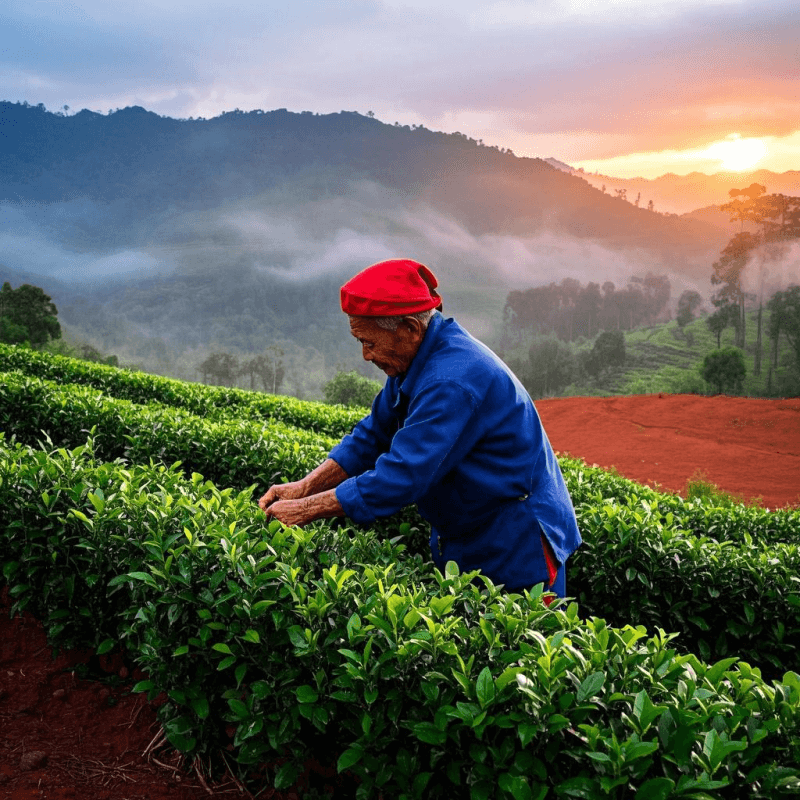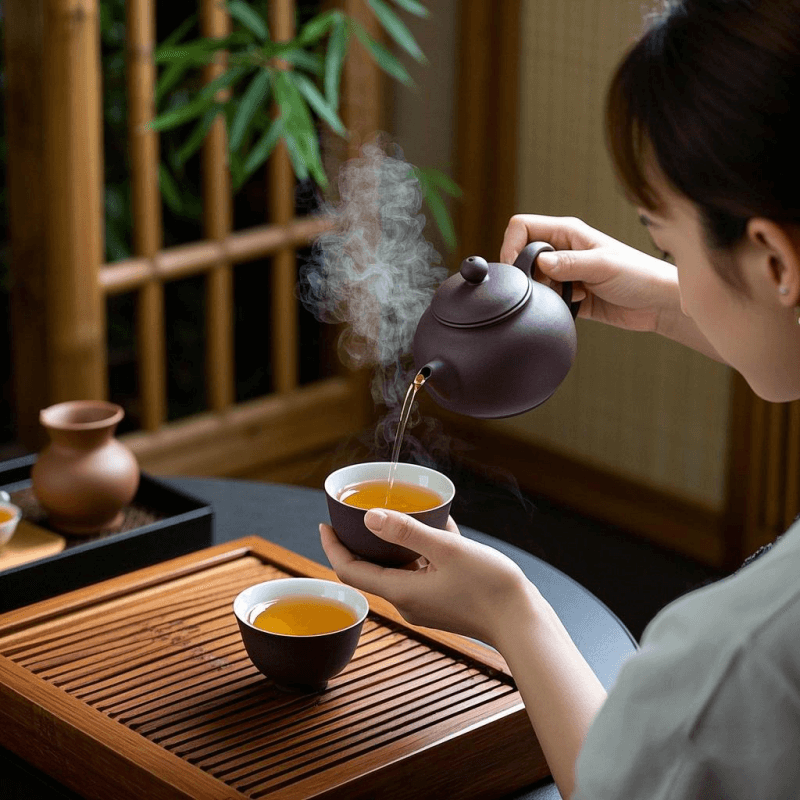1. Introduction: The Irresistible Allure of Dan Cong Oolong Tea

In the vast world of oolong tea, few varieties command attention like dan cong oolong tea. Hailing from China’s misty Phoenix Mountains, this tea isn’t just a beverage—it’s a sensory journey, celebrated for its extraordinary range of aromas that mimic flowers, fruits, honey, and even tropical spices. What makes dan cong oolong tea so special? Its ability to capture nature’s most delicate scents in a single cup, a feat no other tea achieves with such consistency.
For tea enthusiasts, dan cong oolong tea is a treasure hunt for flavors. Each sip reveals layers of aroma, from bright orchid to ripe lychee, with nuances that evolve as the tea cools. Unlike mass-produced teas, every batch of dan cong oolong tea tells a story of tradition, terroir, and meticulous craftsmanship. In this guide, we’ll uncover why this unique brew has earned a reputation as one of the world’s most aromatic and sought-after teas.
2. Origins and Historical Roots: A Legacy of Tea Craftsmanship
To understand dan cong oolong tea, we must start in its only true home: the Phoenix Mountains (Fenghuang Shan) in Guangdong Province, China. For over 700 years, this region has nurtured tea bushes that produce the leaves for dan cong oolong tea, a tradition dating back to the Ming Dynasty (1368–1644).
The term “dan cong” translates to “single bush,” a nod to the tea’s unique production method: each batch is harvested from a single, ancient tea tree, some of which are over 100 years old. Early farmers discovered that different bushes developed distinct flavors based on their location, soil, and exposure to sunlight, leading to the practice of isolating and processing each bush’s leaves separately. This dedication to single-bush integrity is what sets dan cong oolong tea apart from other tea varieties, which are often blended from multiple plants.
By the Qing Dynasty, dan cong oolong tea had become a favorite of emperors, prized for its aromatic complexity. Today, it remains a symbol of Chinese tea heritage, with farmers preserving traditional methods while sharing this remarkable brew with the world.
3. The Science Behind Dan Cong Oolong Tea’s Unique Aroma
What makes dan cong oolong tea smell like flowers, fruits, or honey? The answer lies in its chemical makeup, shaped by genetics, environment, and processing. Aroma scientists have identified hundreds of volatile compounds in dan cong oolong tea that contribute to its signature scents, far more than in most other tea varieties.
🌸 Key Aroma Compounds
- Terpenes: These organic compounds, found in plants like flowers and citrus, create floral and fruity notes. In light dan cong oolong tea, linalool (a terpene) produces lavender or orchid aromas, while limonene adds citrus brightness.
- Esters: Formed during oxidation, esters contribute sweet, fruity scents—think pear, apple, or lychee, common in medium-oxidized varieties.
- Pyrazines: Developed during gentle roasting, these compounds add nutty, caramel undertones to darker dan cong oolong tea.
As TeaDB explains, “The diversity of aroma compounds in Dan Cong is unmatched, making it a ‘living laboratory’ for tea scent research.” This chemical richness is why dan cong oolong tea can smell like a garden one moment and a fruit basket the next—all from a single leaf.
4. What Shapes Dan Cong Oolong Tea’s Flavor and Aroma?
The magic of dan cong oolong tea lies in the perfect storm of factors that converge to create its unique aroma. From the soil to the harvest, every step leaves an imprint on its flavor.
🌍 Terroir: The Mountain’s Gift
Fenghuang Shan’s rugged terrain—red clay soil rich in iron, high altitude (600–1,200m), and misty microclimates—plays a starring role. The thin air and dramatic temperature swings (cool nights, warm days) slow leaf growth, allowing more time for aroma compounds to accumulate. Rainwater, filtered through granite, infuses leaves with minerals that enhance sweetness, while frequent fog protects delicate oils from breaking down in harsh sunlight.
🌱 Single-Bush Genetics
Unlike most teas, which blend leaves from multiple bushes, dan cong oolong tea comes from individual “mother bushes” (some over 300 years old). Each bush has unique genetic traits: one may naturally produce lychee-scented leaves, another jasmine, and another honey. Farmers propagate cuttings from these prized bushes to preserve their distinct aromas, creating “clones” that maintain the original’s scent profile.
👨🌾 Traditional Processing
Crafting dan cong oolong tea is a labor of love, with steps tailored to amplify aroma:
- Withering: Leaves dry in shaded air to activate enzymes, kickstarting flavor development.
- Shaking/Rolling: Gentle shaking bruises leaf edges, releasing oils and accelerating oxidation—critical for ester formation.
- Oxidation Control: Farmers monitor leaves hourly, stopping oxidation at 20–50% to lock in specific scents (less oxidation preserves floral notes; more brings out fruitiness).
- Low-Temp Roasting: Brief roasting (100–120°C) deepens aroma without overpowering it, a technique refined over centuries.
5. How to Brew Dan Cong Oolong Tea for Maximum Aroma

To unlock the full aroma of dan cong oolong tea, brewing matters as much as the tea itself. Unlike generic teas, this variety thrives on precise techniques that honor its delicate compounds.
🔍 Tools You’ll Need
- A small clay teapot (Yixing clay is ideal, as it absorbs and enhances aromas over time).
- Filtered water (low mineral content prevents masking delicate scents).
- A thermometer to monitor water temperature.
- A tea tray and small cups for tasting.
📝 Step-by-Step Brewing Guide
- Prep the Teapot: Rinse the teapot with hot water to warm it, then discard the water. This prevents temperature shock to the leaves.
- Measure the Leaves: Use 5–7g of dan cong oolong tea per 100ml of water (more than you’d use for generic teas to highlight aroma).
- Water Temperature: Heat water to 185–195°F (85–90°C). Too hot (over 200°F) can burn leaves, dulling aroma; too cool won’t extract full flavor.
- Wash the Leaves: Pour hot water over the leaves, swirl briefly, and discard immediately. This “wakes up” the leaves, releasing initial aromas.
- First Steep: Steep for 20–30 seconds. The first pour is light but fragrant—note the initial floral or fruity burst.
- Subsequent Steeps: Add 10–15 seconds per steep. Dan cong oolong tea shines over 5–8 steepings, with later cups revealing deeper, sweeter notes (honey, caramel).
Learn how to brew dan cong oolong tea the traditional way to experience its evolving aromas—each steep tells a new part of its story.
6. Taster Reviews: Real Experiences with Dan Cong Oolong Tea
Tea enthusiasts worldwide rave about dan cong oolong tea’s aroma, often describing it as a “sensory adventure.” Here’s what real drinkers have to say:
- “I tried the Lychee Dan Cong, and it’s mind-blowing—you’d swear there are fresh lychees in the cup! The aroma fills the room, and each steep gets sweeter. It’s replaced my morning coffee.” — James L., tea collector
- “As someone who loves floral teas, the Osmanthus Dan Cong is my holy grail. The aroma is like walking through a blooming garden, and it’s smooth enough to drink all day without bitterness.” — Maya K., tea blogger
- “I was skeptical about ‘single-bush’ tea until I tried Da Hong Pao Dan Cong. The roasted honey aroma is so rich, I steep it at night to unwind. It’s now my ‘stress relief ritual.’” — Thomas W., regular customer
These reviews highlight why dan cong oolong tea stands out: its aroma isn’t just a scent—it’s an experience that lingers in memory.
7. Conclusion: Why Dan Cong Oolong Tea Deserves a Spot in Your Cupboard
In a world of mass-produced teas, dan cong oolong tea is a testament to craftsmanship and nature’s diversity. Its unique aroma—shaped by ancient bushes, mountain terroir, and time-honored processing—offers something no other tea can: a sensory journey that evolves with every steep.
Whether you’re drawn to floral, fruity, or nutty notes, there’s a dan cong oolong tea to match your taste. It’s more than a beverage; it’s a connection to centuries of tea culture, a reminder of how patience and tradition create something extraordinary.
Discover premium dan cong oolong tea with authentic aroma and experience why it’s cherished by tea connoisseurs worldwide. From the first whiff to the last sip, dan cong oolong tea proves that some of life’s greatest pleasures come from the simplest leaves.
Explore the unique aroma of dan cong oolong tea—why this rare oolong stands out with floral, fruity scents. Discover its origins, brewing tips, and why it’s a must-try for tea lovers.
Explore our exclusive dan cong tea collection for connoisseurs and taste the difference that tradition and terroir make in every cup. Taste the signature floral notes of dan cong oolong with every sip—your senses will thank you.
As Healthline notes, “High-quality oolong teas like Dan Cong contain unique antioxidants and aroma compounds that contribute to both flavor and wellness benefits.” This further underscores why this aromatic variety is cherished by tea lovers globally.
